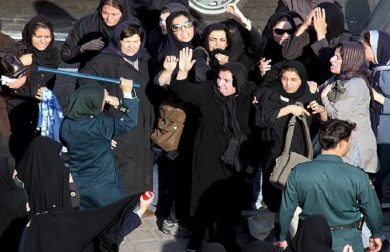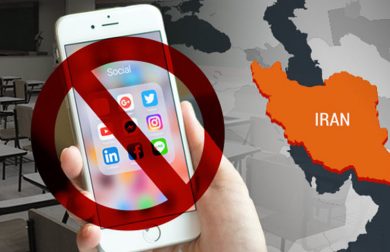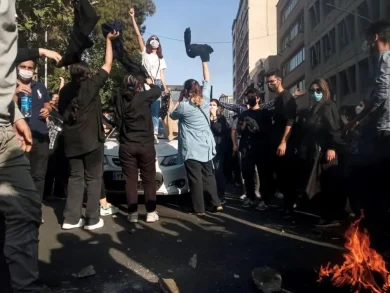For decades, the Islamic Revolutionary Guard Corps (IRGC) has been the primary enforcer of state repression in Iran, targeting political dissidents, journalists, activists, and anyone who threatens the regime’s grip on power. Among its greatest threats, however, are Iranian women—who have consistently challenged the regime’s patriarchal control, oppressive laws, and systematic discrimination.
The IRGC fears women because their leadership, resilience, and resistance strike at the very foundation of the Islamic Republic’s authoritarian rule. Women’s fight for bodily autonomy, legal equality, and political participation undermines the regime’s ideology, which relies on gender-based oppression to maintain control.
This article explores:
• Why Iranian women’s leadership poses a unique threat to the IRGC.
• How women-led resistance movements are shaping Iran’s future.
• The tactics of repression the IRGC uses against women.
• The global significance of Iranian women’s fight for freedom.
1. Why the IRGC Sees Women as a Threat
A. Women Challenge the Regime’s Ideology
The Islamic Republic’s legitimacy is built on a strict interpretation of gender roles, where women are expected to be submissive, veiled, and politically silent. Iranian women’s fight for freedom and equal rights fundamentally challenges this ideology by:
• Rejecting forced hijab laws, which symbolize state control over women’s bodies.
• Demanding legal rights in marriage, divorce, and child custody.
• Participating in protests and civil disobedience, showing that women are not passive subjects but active agents of change.
By defying these restrictions, women expose the regime’s fear of losing control and challenge its political and religious legitimacy.
B. Women Mobilize Mass Resistance
Iranian women are not just protesting individually—they are leading mass movements that unite different sectors of society, including:
• Students and academics advocating for political freedom.
• Workers and labor activists fighting against economic injustice.
• Ethnic minorities who face both gender and racial oppression.
The “Women, Life, Freedom” movement, sparked by the death of Mahsa Amini, became a nationwide uprising because it connected gender oppression to larger struggles for democracy and human rights.
The IRGC understands that when women lead, revolutions gain momentum—and that is exactly what they fear.
C. Women’s Resistance is Harder to Justify Repressing
While the IRGC has historically used violence to crush political dissent, repressing women-led movements carries greater consequences:
• Domestic backlash: Iranian society increasingly supports women’s rights, making violent crackdowns less effective.
• International condemnation: Images of women being beaten, arrested, and killed fuel global pressure on the Iranian regime.
• Religious contradictions: While the regime claims to uphold Islamic values, attacking women exposes its hypocrisy.
This forces the IRGC into a losing battle—if they ignore women’s resistance, it grows. If they crack down, it sparks more outrage and solidarity.
2. The IRGC’s Methods of Silencing Women
A. Mass Arrests and Torture
The IRGC has systematically arrested thousands of women for:
• Removing their hijabs in public.
• Reporting on human rights abuses.
• Participating in protests and strikes.
Women detained by the IRGC often face:
• Torture and beatings to extract forced confessions.
• Sexual abuse as a tool of humiliation and control.
• Long prison sentences based on fabricated charges of “corruption on earth” or “acting against national security.”
B. Targeting Women Journalists and Activists
The IRGC sees independent female journalists as major threats because they expose state corruption and repression.
• Journalists like Niloofar Hamedi were imprisoned for reporting on Mahsa Amini’s death.
• Women’s rights activists like Narges Mohammadi have spent years in prison for demanding gender equality.
By imprisoning and torturing female journalists, the IRGC attempts to silence the truth—but instead, their stories gain global attention.
C. Digital Repression and Surveillance
The IRGC uses cyber warfare to:
• Monitor and censor women’s online activism.
• Hack accounts and spread disinformation to discredit women’s movements.
• Cut off internet access during protests to prevent women from organizing.
Despite these efforts, Iranian women continue to use encrypted apps, VPNs, and satellite communication to share their stories with the world.
3. How Women Are Reshaping Iran’s Future
A. Leading Protests and Civil Disobedience
From schoolgirls refusing to wear hijabs to mothers demanding justice for their executed sons, women are driving Iran’s civil resistance through:
• Public acts of defiance (e.g., walking unveiled, burning headscarves).
• Organizing underground networks to resist IRGC repression.
• Educating young girls on their legal rights and freedoms.
These actions chip away at the regime’s authority, proving that Iranian women will not be silenced.
B. Inspiring a New Generation of Leadership
Iranian women are setting a historic precedent—they are not just demanding rights for themselves, but for:
• Workers fighting for economic justice.
• Religious minorities seeking equal protection.
• Students and young activists demanding democracy.
By leading these movements, women are proving that Iran’s future will be built on inclusion, equality, and justice.
C. Gaining Global Recognition and Support
Women like Narges Mohammadi, Masih Alinejad, and Shirin Ebadi have turned Iran’s women-led movement into a global human rights campaign.
• The Nobel Peace Prize awarded to Narges Mohammadi highlights the international community’s recognition of Iranian women’s struggle.
• Global protests in support of Iranian women have pressured governments to impose sanctions on IRGC officials.
This growing global solidarity is making it harder for the IRGC to continue its repression unchecked.
4. Why the Future of Iran is Female
A. Women’s Rights are Central to Iran’s Democracy
Iran cannot be free if half of its population remains oppressed. Women’s demands for:
• Bodily autonomy
• Legal equality
• Political representation
Are directly tied to the country’s fight for democracy and human rights.
B. The IRGC is Losing the Battle Against Women
Despite:
✔ Decades of forced veiling laws
✔ Brutal crackdowns on protests
✔ Media censorship and propaganda
Women’s resistance is stronger than ever. The IRGC cannot control an entire generation of women who reject its authority.
C. Global Pressure is Increasing
• More countries are considering designating the IRGC as a terrorist organization.
• Sanctions are targeting Iranian officials responsible for women’s oppression.
• Digital activists are keeping the movement alive despite censorship.
As international support grows, the IRGC’s power to suppress women is weakening.
Conclusion: Women Will Break the IRGC’s Grip on Iran
The IRGC fears Iranian women because they represent the greatest threat to its survival. Women’s leadership, activism, and resilience challenge the regime’s legitimacy at its core.
Despite arrests, torture, and censorship, Iranian women continue to resist, proving that no amount of repression can stop their fight for freedom.
Join Our Newsletter!
Stay informed with the latest updates, news, and ways to take action in the fight for justice and global security. Sign up now to get updates delivered straight to your inbox!





